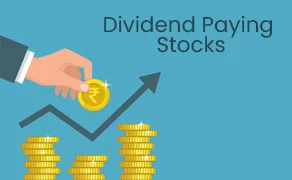Stocks that pay dividends are those that are held by publicly traded firms that pay dividends to their shareholders as a percentage of their earnings. Companies use these dividends to distribute their profits to their investors on a regular basis, such as quarterly, semi-annually, or annually.

The following are the main ideas to comprehend regarding dividend-paying stocks:
- Income Distribution: By purchasing dividend-paying stocks, you take a stake in the business. The business allots a percentage of its profits to be distributed to shareholders as dividends in exchange for your investment. Investors can rely on these dividends as a reliable source of income.
- Companies that Pay Dividends: Businesses that pay dividends typically have a longer track record and are more reliable. They frequently have a track record of steady profitability and cash flow, which appeals to investors looking for investments with lesser risk as well as those who are interested in income.
- Dividend Yield: A crucial statistic for assessing dividend-paying equities is the dividend yield. In proportion to the stock’s current market price, it shows the annual dividend payment. Investors can use it to evaluate a stock’s income potential in relation to its price.
- Types of Dividends:Different types of dividends exist, including cash dividends (direct cash payments to shareholders), stock dividends (more shares of stock granted to shareholders), and hybrid dividends (a combination of both). The most typical type of payout is cash.
- Dividend Growth: Some businesses have a track record of gradually raising their dividend payouts. These stocks are referred to as “dividend growth” stocks, and investors who want their income stream to keep up with inflation and possibly increase over time favour them.
- Dividend taxation: Depending on the nation and the specific circumstances of the investor, dividend taxation can vary. Dividend income may be subject to lower tax rates than other types of income in some jurisdictions.
- Investor Considerations: When assessing dividend-paying equities, investors frequently take into account a company’s financial stability, dividend history, and dividend payout ratio (the proportion of earnings distributed as dividends). To guarantee that the business can keep paying dividends in the future, a sustainable dividend policy is essential.
Advantages and Disadvantages of Dividend Paying Stocks?
Advantages
- Steady Income Stream: One of the main advantages is that they offer investors a consistent flow of income in the form of dividends. This may be especially interesting to retirees or investors looking for income.
- Income Stability: Businesses that regularly pay dividends frequently have dependable and established business practises. Compared to growth companies, they are less likely to be extremely volatile, which might provide investors a sense of stability.
- Performance in the Past: In the past, dividend-paying stocks have beaten non-dividend-paying stocks in the long run. Because of this, they may be a desirable alternative for investors seeking a mix of income and possible capital growth.
- Tax advantages: Dividend income may be taxed at a lower rate than other investment income types like interest or capital gains in some jurisdictions. Investors may benefit tax-wise as a result of this.
Disadvantages
- Lower Growth Potential: Compared to high-growth or tech stocks, dividend-paying equities, especially those from established businesses, may have less room for development. These stocks might not appeal as much to investors looking for large capital gains.
- Interest Rate Sensitivity: Changes in interest rates may have an impact on dividend stocks. Dividend yields can seem less alluring when interest rates increase, which could result in a drop in stock prices.
- Dividend reductions: Businesses may reduce or stop paying dividends, particularly in difficult economic or financial times. This may cause investors to lose money and have a negative effect on the stock’s price.
- Limited Tax Efficiency: Dividend income is taxed more heavily in some nations than capital gains. Investors’ after-tax returns may be impacted by this, particularly those in higher tax bands.
- Neglected Growth possibilities: Businesses that place a high priority on dividend payments may allot less money for investments in growth possibilities, which may reduce their capacity for long-term growth.
- Stock Price Impact: A stock’s price often drops by about the dividend amount on the day it goes ex-dividend (the day after which a buyer no longer has the right to receive the following dividend payment). The value of the stock may briefly fluctuate as a result of this.
Conclusion
In conclusion, dividend-paying stocks are shares of well-established, financially secure businesses that regularly pay dividends to shareholders in the form of cash. These companies are frequently preferred by people looking for stability in their investing portfolio because they provide investors with a reliable source of income.
Investors thinking about dividend stocks should evaluate elements such the firm’s financial stability, dividend history, and dividend yield. Stocks that pay dividends can offer an alluring combination of income and, in some cases, long-term growth potential. They might not, however, provide as much capital gain as high-growth stocks.
Ultimately, a person’s financial objectives, risk tolerance, and investment strategy should all be taken into consideration when deciding whether to invest in dividend-paying companies. A portfolio’s diversification by including a variety of assets, such as dividend-paying companies, can assist in developing a well-balanced and comprehensive investment strategy.
FOR MORE INFO CLICK THIS SITE:https://learningsharks.in/
FOLLOW OUR PAGE:https://www.instagram.com/learningsharks/?hl=en
